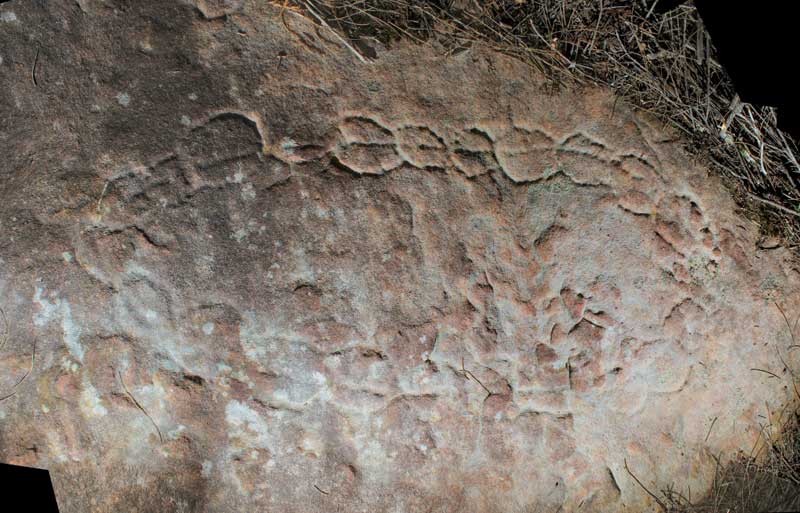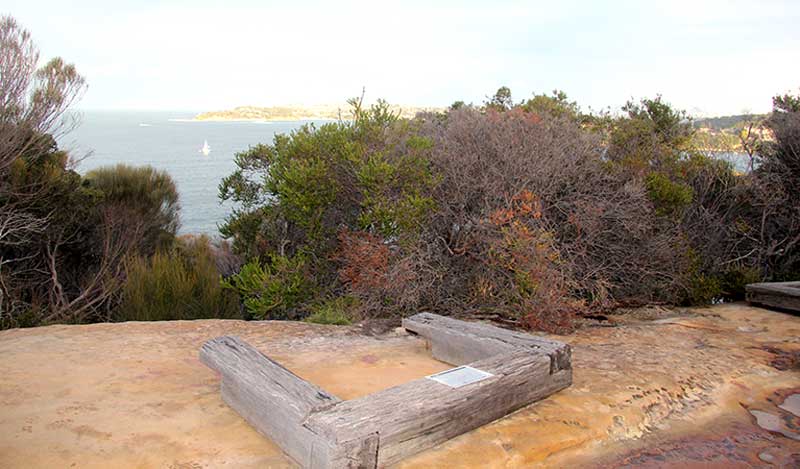Sydney's Aboriginal Heritage

Gumbooya Reserve
Gumbooya Reserve, Allambie Heights: 68 rock carvings including fish, hunting implements, a dolphin and a large human figure which appears to be inside or on top of a whale. The carvings, which are well sign posted and fenced, are in a location which offers panoramic views up and down the coast, as well as inland, an indication it was in all probability a sacred site.
Warriewood: numerous engravings, the least worn being a series of eels and a spear, are to be found near Narrabeen Creek.
Palm Beach: Many of the rocky headlands along the northern beaches contain rock carvings of some description, however most are faded due to exposure to wind, rain and surf. The engravings of fish, human footprints, a goanna, a boomerang, and some fish, located at the southern end of Palm Beach, are some of the easiest to find. Another site exists on private property on Pacific Road. Located high on a ridge and offering extensive views to the ocean and Pittwater, the site contains an engraving of a man with a fish inside the outline.

Bantry Bay engravings site
Bantry Bay: The most extensive single group of carvings in the Sydney metropolitan area are located on a rocky outcrop on the hillside above Bantry Bay and accessed via the Engravings Track alongside Wakehurst Parkway 400m south of the end of Bantry Bay Road, Frenchs Forest. There are some 82 figures, including two mundoes, people, animals, fish, shields, a canoe, a basket and bag, boomerangs, circles, stone axes and clubs, snakes and a whale. One group of figures shows two men, one of whom is carrying bark canoes.
As they are on flat open ground, sadly these carvings have suffered greatly from exposure to the weather and many have faded so badly there are only recognisable to the trained eye. The best time to view them is at dawn or dusk. Other engravings occur in the surrounding bushland but they are not easy to find as they are not marked, and are often in locations where fallen leaves and other bush debris have covered them. Middens and rock shelters can be seen on the shores of the bay. Tool sharpening grooves have been found near the engravings and creek beds.
Oxford Falls: Moon Rock has become well known for about 50 engravings which depict different phases of the moon, tools and weapons used and animals caught and eaten in the area. Moon Rock was a traditional gathering place to meet, learn and heal. The site still holds significant Aboriginal cultural values and has a direct connection to country for the local Aboriginal community. The Moon Rock engravings site is in an area of bushland to the north east of Morgan Road, Belrose.

Moon Rock engravings site
Moon Rock is a particularly significant site as it gives rare evidence of the Aborigines having astronomical knowledge, as it depicts eight lunar phases, along with Baiame the creator-spirit, local totems, food, weapons and whales and stingrays. It is no surprise that they were able to work this out and how their lives depended on the different seasons, and not just the four seasons that the colonials brought with them. The moon was usually viewed as a bad-man/creator-spirit who committed various crimes.

Moon Rock engravings site
The phases of the moon represent stages of his health as he is punished for his crimes, as a result of which he dies (the new moon) and then, after remaining dead for three nights, returns to life. The moon was also important in practical terms, as ceremonies were often held on the full moon, and the cycles of the moon were frequently used to count periods of time, like a calendar, and for a deep understanding of the tides and cycle of tidal movements. Lunar haloes were used as important weather predictors: stars visible inside a halo meant there would be no rain for days.

an engraving of a string of cowrie shells, Wheeler Heights
Wheeler Heights: An aboriginal engraving platform at Wheeler Heights/Cromer Heights has a line of mundoes leading across to a cave and another line leading to a scene that shows a successful kangaroo hunt. Two male figures stand by two speared kangaroos. There are also a number of fish and other unusual carvings including a wobbegong and a shark (?). Another engraving appears to show a chain of large cowrie shells. This engraving is about one metre wide. Cowrie shell necklaces were considered to be of great value and one this size would probably only be worn for ceremonial purposes. The Art Gallery of NSW has some examples of these cowrie shell necklaces. A hunting boomerang is also depicted - a hunting boomerang is not designed to return but is mainly for injuring or killing animals or enemies. These engravings are located on publicly accessible land, however the exact location of which is not published here.
- More Information

Terrey Hills: Down a bush track off Larool Road adjacent to the Terry Hills Golf Course is a group of Aboriginal rock carvings. The site is said to have belonged to the Darkinjung People, a local clan. The carving is of a man with a long penis (supposedly the longer the penis, the more Spiritiual Creator), two women, a number of kangaroos and wallabies and human like footprints called Mundoes. The scene depicted seems to show a successful hunt, as one kangaroo has a spear in its back. The presence of an over-endowed male and his headdress usually signifes a creator spirit being, possibly Baiaime. Mundoes are generally restricted to sacred sites as they indicate a spiritual path to be followed. Nearby are rocks with other animals depicted on them, and a small watercourse with axe grinding grooves.
WARNING: These sites contain irreplaceable examples of the art of the indigenous peoples of the Sydney region. The engraving and rock paintings found at these sites are a reminder of a people who once lived in the Sydney region and as such are valuable part of their history and the history of Sydney that will be lost forever if it not treated with respect. Please do not deface or add to the art, as it is part of our heritage. All such sites protected by law, and to deface, modify or remove them in part or in whole is a criminal offence.
It is believed that over 6,000 drawings, most of which are carved into sandstone rock faces, once existed throughout what is now the Sydney metropolitan area, but many have been destroyed, bulldozed or blasted out of existence to make way for farms, bridges and later, suburbs. In most cases, those clearing the land or responsible for it did not know about the art's existence, nor did they have any inkling as to its value as either the last remaining evidence of a new vanished culture, its spiritual and religious importance to the survivors of that culture or as a part of Sydney's heritage. As there has been no one to maintain them for over 2 centuries, many of the examples of rock art which have managed to escape the onslaught of the bulldozer and pick axe have suffered the onslaught of wind, sand and sea erosion, being walked on, driven on and vandalised.
To protect what is left, the Government has wisely brought all Aboriginal sites in New South Wales under the protection the National Parks & Wildlife Act 1974. Under the act, it is illegal to disturb, damage, deface or destroy any relic, a relic being defined as any deposit, object or material evidence relating to indigenous & non European habitation of New South Wales (not being handicraft made for sale). By definition, this includes middens, habitation sites, rock carvings, rock paintings, scarred trees, stencils, stone arrangements, stone implements and tools. Though they have been given legislative protection, there is little known about the best way to manage Aboriginal sites. To western eyes, the ideal would be to turn the maintenance of sites over to the Aboriginal people. This sounds good in theory, however, under Aboriginal law, only select people are permitted to maintain the art at these sites. Where those select people cannot be found, or if there are no survivors from a particular tribe, no one can touch the art created by and for that tribe. Even so, the art is considered sacred to the Aborigines, so there is reluctance among the Aboriginal communities to maintain the art if it is to turned into something to make money from by showing it to tourists.
Consequently, the authorities have adopted a policy of keeping the public in the dark about the location of much of Sydney's Aboriginal sites. The thinking behind it seems to be "what the people don't know about the people can't damage". As the damage caused in the past has occurred mainly as a result of ignorance, some would argue that education of the public is a better way to deal with the problem than maintaining their ignorance. When the public do come across it, and can be vandalised, even unintentionally, as it has no relevance, hence no value to them.

Engravings site, Grotto Point, Balgowlah

What Is An Aboriginal Site?
It is believed that over 6,000 drawings, most of which are carved into sandstone rock faces, once existed throughout what is now the Sydney metropolitan area, but many have been destroyed, bulldozed or blasted out of existence to make way for farms, bridges and later, suburbs.
- More
- More
Protecting Aboriginal Sites
The only surviving record of Aboriginal culture by the Aboriginal people themselves is contained in their art, found on rocks and in caves across the country. In the Sydney region, some 600 rock art sites have been recorded with over 4,000 separate figures mainly of plants, animals, fish and people, which recall the dreamtime and events from the past.
Aboriginal Sites in the Sydney Region




